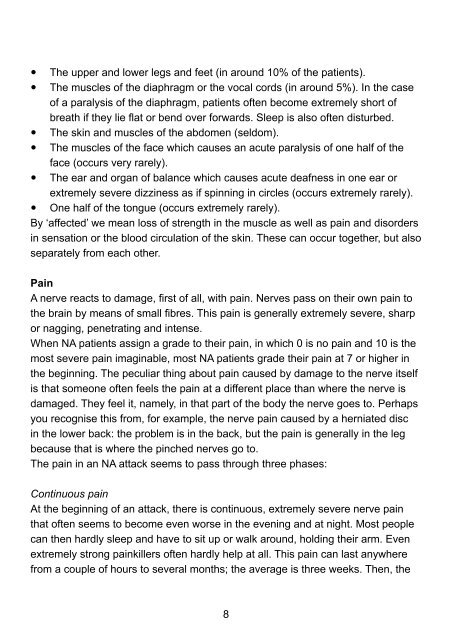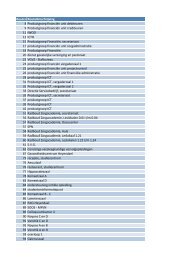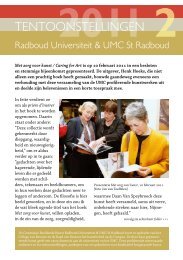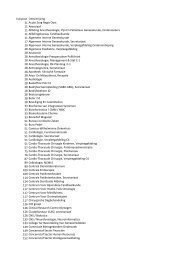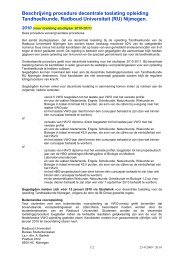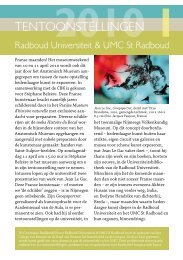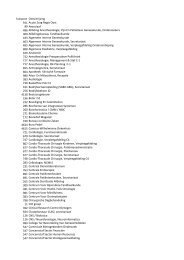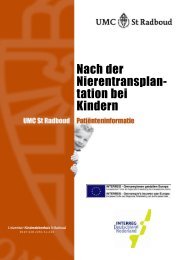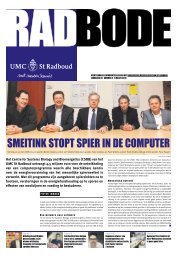Neuralgic Amyotrophy: idiopathic and hereditary ... - UMC St Radboud
Neuralgic Amyotrophy: idiopathic and hereditary ... - UMC St Radboud
Neuralgic Amyotrophy: idiopathic and hereditary ... - UMC St Radboud
You also want an ePaper? Increase the reach of your titles
YUMPU automatically turns print PDFs into web optimized ePapers that Google loves.
• The upper <strong>and</strong> lower legs <strong>and</strong> feet (in around 10% of the patients).<br />
• The muscles of the diaphragm or the vocal cords (in around 5%). In the case<br />
of a paralysis of the diaphragm, patients often become extremely short of<br />
breath if they lie flat or bend over forwards. Sleep is also often disturbed.<br />
• The skin <strong>and</strong> muscles of the abdomen (seldom).<br />
• The muscles of the face which causes an acute paralysis of one half of the<br />
face (occurs very rarely).<br />
• The ear <strong>and</strong> organ of balance which causes acute deafness in one ear or<br />
extremely severe dizziness as if spinning in circles (occurs extremely rarely).<br />
• One half of the tongue (occurs extremely rarely).<br />
By ‘affected’ we mean loss of strength in the muscle as well as pain <strong>and</strong> disorders<br />
in sensation or the blood circulation of the skin. These can occur together, but also<br />
separately from each other.<br />
Pain<br />
A nerve reacts to damage, first of all, with pain. Nerves pass on their own pain to<br />
the brain by means of small fibres. This pain is generally extremely severe, sharp<br />
or nagging, penetrating <strong>and</strong> intense.<br />
When NA patients assign a grade to their pain, in which 0 is no pain <strong>and</strong> 10 is the<br />
most severe pain imaginable, most NA patients grade their pain at 7 or higher in<br />
the beginning. The peculiar thing about pain caused by damage to the nerve itself<br />
is that someone often feels the pain at a different place than where the nerve is<br />
damaged. They feel it, namely, in that part of the body the nerve goes to. Perhaps<br />
you recognise this from, for example, the nerve pain caused by a herniated disc<br />
in the lower back: the problem is in the back, but the pain is generally in the leg<br />
because that is where the pinched nerves go to.<br />
The pain in an NA attack seems to pass through three phases:<br />
Continuous pain<br />
At the beginning of an attack, there is continuous, extremely severe nerve pain<br />
that often seems to become even worse in the evening <strong>and</strong> at night. Most people<br />
can then hardly sleep <strong>and</strong> have to sit up or walk around, holding their arm. Even<br />
extremely strong painkillers often hardly help at all. This pain can last anywhere<br />
from a couple of hours to several months; the average is three weeks. Then, the<br />
8<br />
pain generally subsides to a grade of 5 or less. We think that this initial pain is<br />
because the nerves are inflamed (see also chapter 6: Causes).<br />
Pain when moving<br />
After the period of continuous pain in the beginning, there is generally a phase in<br />
which the shoulder or arm does not hurt anymore when resting but, with specific<br />
movements or positions, sudden sharp shooting pains can occur. This pain subsides<br />
a bit within a couple of hours. Most likely, this pain is the result of a hypersensitivity<br />
of the damaged nerve to stretching or pressure. It is slightly comparable<br />
to a nerve in a tooth that is exposed in a cavity: if you touch the tooth, you get a<br />
shooting pain in it. Generally, this hypersensitivity of the nerves with NA subsides<br />
gradually after a few months. In some people, however, the nerves remain sensitive<br />
to stretching <strong>and</strong> pressure for a very long time. This can be because scar<br />
tissue has developed so that the nerves lose some of their elasticity <strong>and</strong> cannot<br />
move as easily in their sheath. If the arm is moved, this pulls more than usual on<br />
the bundle of nerve fibres <strong>and</strong> causes irritation or a shooting pain.<br />
Chronic pain<br />
Many NA patients develop a kind of chronic muscle pain in the area of the (partially)<br />
paralyzed muscles <strong>and</strong> the places where they are attached to the bone or a<br />
joint. In particular, muscles that must actually be tensed all day long (for example,<br />
the muscles that keep the shoulder blade in place on the torso) are sensitive for<br />
this. People also have pain in the non-affected muscles that are overburdened<br />
because they must take on all the work of the partially paralyzed muscles. In<br />
practice, this often causes pain in the area between the neck <strong>and</strong> the back of the<br />
head, around the shoulder blade <strong>and</strong> under the armpit on the torso. This chronic,<br />
nagging pain is often very uncomfortable <strong>and</strong> can hardly be treated at with<br />
medication or rest. What helps the most is finding an adequate balance between<br />
activities <strong>and</strong> rest, with the help of treatment by an occupational therapist <strong>and</strong> a<br />
physical therapist working together. These therapists can provide you with an explanation<br />
of what is going on. They can show you in the practice what it is you are<br />
doing, <strong>and</strong> how that is reinforcing the symptoms. By learning to move differently,<br />
you can gradually decrease the symptoms. Alongside of that, your physiotherapist<br />
will teach you how you can keep the pattern of movement in the affected shoulder<br />
9


